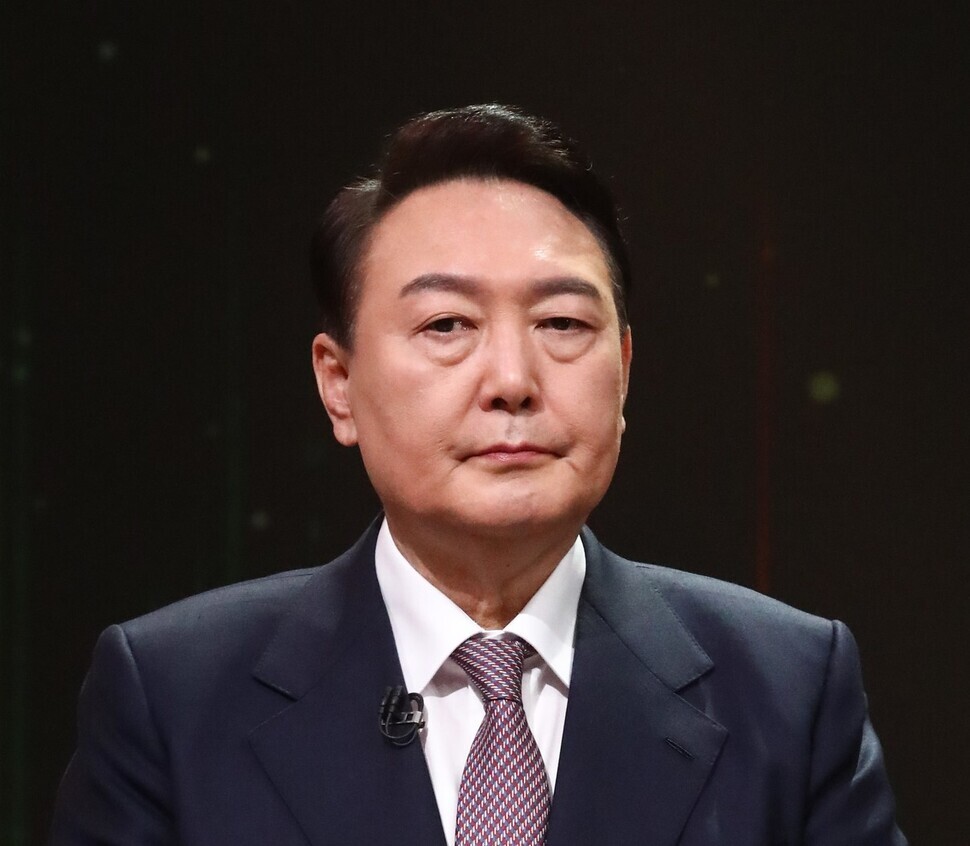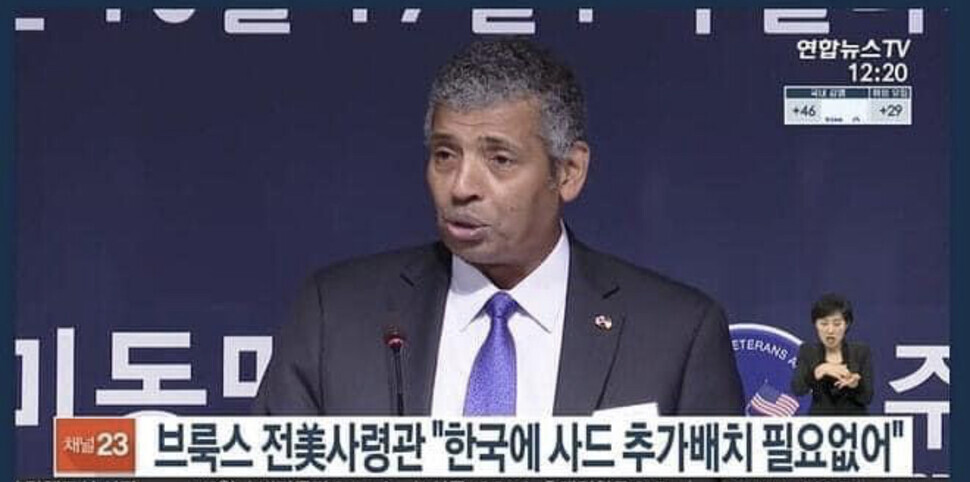hankyoreh
Links to other country sites 다른 나라 사이트 링크
Fact-checking the debate over additional THAAD deployment in S. Korea

During South Korea’s four-way presidential debate held Feb. 4, Democratic Party presidential nominee Lee Jae-myung and People Power Party candidate Yoon Suk-yeol clashed over whether an additional Terminal High Altitude Area Defense, or THAAD, battery should be deployed in the country. Specifically, the two candidates offered two conflicting interpretations of a statement by former US Forces Korea (USFK) Commander Vincent K. Brooks.
Lee said, “Former USFK Commander Brooks said an additional THAAD battery is not necessary [in South Korea], but [Yoon Suk-yeol is] stirring security concerns to gain votes, prompting critiques that [he will] ruin the economy.”
Yoon countered, “Former Commander Brooks said integrating the THAAD system in Seongju with low-level defense systems like the Patriot interceptors would be effective, not that an additional THAAD deployment is not necessary.”

Brooks commanded the USFK from April 2016 to November 2018. As he was serving in the post from July 8, 2016, when South Korea and the US announced the decision to deploy THAAD on South Korean soil, to April 2017, when THAAD missile launchers were installed in Seongju County, North Gyeongsang Province, he is arguably one of the figures most knowledgeable about the THAAD system in South Korea.
The statement by Brooks that Lee and Yoon were referring to was reported by Radio Free Asia (RFA) on Nov. 2, 2020. According to RFA, Brooks said that THAAD can be integrated with existing missile defense systems in South Korea to lead to a better-integrated defense system against North Korean missiles. In particular, he noted its compatibility with the Patriot missile defense system’s radar, intended for low altitude missiles, and the Green Pine radar, which issues early warnings against ballistic missiles.
Citing this statement by Brooks, RFA reported in its Korean edition that “former Commander Brooks told RFA on [Nov. 2 of 2020] that an additional THAAD deployment in South Korea is not necessary [. . .] because the existing THAAD battery can be integrated with other missile defense systems to protect South Korea from the threat of North Korean missiles” — conveying Brooks’ message through a more clearly worded commentary while titling the article containing the quote, “Former Commander Brooks: Additional THAAD deployment in South Korea not necessary.”
Many domestic news outlets in South Korea subsequently cited RFA’s article in their news coverage. Assuming that the reporter who wrote the RFA article interpreted Brooks’ statement in faith, the former commander likely meant that an additional deployment of THAAD in South Korea is not needed.
In spite of this, the People Power Party is continuously arguing that “former USFK Commander Brooks said in an interview that ‘THAAD would be more effective if integrated with the Patriot and Green Pine radars’ without ever mentioning anything about an additional THAAD deployment [in South Korea].”

During the presidential debate, Yoon repeatedly emphasized the need for an additional THAAD battery in South Korea, saying, “Because the chance of a high-angle [missile] launch is significant if North Korea targets the greater Seoul area, [an additional THAAD battery] is necessary in the greater Seoul area as a matter of course.”
Because Patriot II and III and Cheongung III — all part of the South Korean military’s current missile defense system — are only capable of intercepting enemy missiles in low altitudes of around 20 km and medium altitudes of around 30 km, Yoon reasoned that another THAAD battery is needed in the country to respond to missiles in high altitudes of 50 km to 150 km.
Ballistic missiles are typically fired at angles between 30 degrees and 45 degrees. During a high-angle launch, they are deliberately fired at a higher angle to reduce their range, blasted off almost vertically at angles nearing 90 degrees. For example, though the intermediate-range ballistic missile (IRBM) Hwasong-12 launched by North Korea on Jan. 30 has a typical range of 4500 km to 5000 km, it only traveled 800 km because it was launched at a high angle.
When test launching medium- and long-range ballistic missiles, which are capable of reaching Japan, Hawaii, and the US territory of Guam, North Korea has deliberately reduced the projectiles’ flight distance through high-angle launches. The idea for North Korea has been to advance its medium- to long-range ballistic missile capabilities without overly provoking the US.
In order to attack South Korea with a medium- or long-range ballistic missile with a maximum range of over 1000 km on as small a landmass as the Korean Peninsula, North Korea has to launch the missile at a high angle. However, considering that North Korea has over 1,000 warheads of relatively cheap short-range missiles in its arsenal in order to target South Korea, there’s no real reason for North Korea to use medium- or long-range missiles for high-angle launches — that would be too little bang for the buck for North Korea.
Even the Ministry of National Defense during the Park Geun-hye administration concluded that a high-angle missile launch from North Korea targeting the South is unrealistic. On July 20, 2016, then-Minister of National Defense Han Min-goo said at a meeting at the National Assembly that the likelihood of North Korea firing Musudan missiles — which have a maximum range of over 3000 km — at high angles to attack the greater Seoul area is practically nil.
Han said at the time, “North Korea has the firepower and means to attack Seoul other than through high-angle missile launches. It has hundreds of Scud missile warheads alone.” He added, “If North Korea is in its right mind, it has no reason to launch Musudan missiles at high angles.”
The 2016 defense white paper published by the Park administration also concluded that “North Korean ballistic missiles that can threaten the greater Seoul area are the Scud missiles; as they travel in low altitudes and across short distances, the Patriot rather than THAAD is a more useful interceptor system [against the threat of North Korean missiles in the greater Seoul area].”
Even an opinion piece published in the Dong-a Ilbo on Jan. 4 argued, “Though the main opposition party advocated for an additional THAAD deployment, it’s hard not to question the practicality of the insistence for an additional interceptor missile against medium- to long-range missiles when responding to the threat of short-range missiles is more urgent right now.”
Though theoretically possible, a high-angle missile launch by North Korea targeting the greater Seoul area is incredibly unlikely. It’s hard to accept Yoon’s statement that “the chance of a high-angle [missile] launch is significant if North Korea targets the greater Seoul area.”
By Kwon Hyuk-chul, staff reporter
Please direct questions or comments to [english@hani.co.kr]

Editorial・opinion
![[Editorial] Penalties for airing allegations against Korea’s first lady endanger free press [Editorial] Penalties for airing allegations against Korea’s first lady endanger free press](https://flexible.img.hani.co.kr/flexible/normal/500/300/imgdb/original/2024/0502/1817146398095106.jpg) [Editorial] Penalties for airing allegations against Korea’s first lady endanger free press
[Editorial] Penalties for airing allegations against Korea’s first lady endanger free press![[Editorial] Yoon must halt procurement of SM-3 interceptor missiles [Editorial] Yoon must halt procurement of SM-3 interceptor missiles](https://flexible.img.hani.co.kr/flexible/normal/500/300/imgdb/child/2024/0501/17145495551605_1717145495195344.jpg) [Editorial] Yoon must halt procurement of SM-3 interceptor missiles
[Editorial] Yoon must halt procurement of SM-3 interceptor missiles- [Guest essay] Maybe Korea’s rapid population decline is an opportunity, not a crisis
- [Column] Can Yoon steer diplomacy with Russia, China back on track?
- [Column] Season 2 of special prosecutor probe may be coming to Korea soon
- [Column] Park Geun-hye déjà vu in Yoon Suk-yeol
- [Editorial] New weight of N. Korea’s nuclear threats makes dialogue all the more urgent
- [Guest essay] The real reason Korea’s new right wants to dub Rhee a founding father
- [Column] ‘Choson’: Is it time we start referring to N. Korea in its own terms?
- [Editorial] Japan’s rewriting of history with Korea has gone too far
Most viewed articles
- 1[Editorial] Penalties for airing allegations against Korea’s first lady endanger free press
- 2Months and months of overdue wages are pushing migrant workers in Korea into debt
- 3In rejecting statute of limitations defense in massacre case, Korean court faces up to Vietnam War a
- 4Historic court ruling recognizes Korean state culpability for massacre in Vietnam
- 5“Those souls can rest now”: Vietnam massacre survivor reacts to Korean court win
- 6[Editorial] Verdict on Korea’s massacre in Vietnam a first step in atonement
- 7Ruling on Korean atrocity in Vietnam comes 23 years after Hankyoreh 21’s exposé
- 81 in 3 S. Korean security experts support nuclear armament, CSIS finds
- 9[Interview] Continuing the fight for victims of civilian massacres during Vietnam War
- 10Korea’s atrocities in Vietnam, in the words of those who saw and survived them